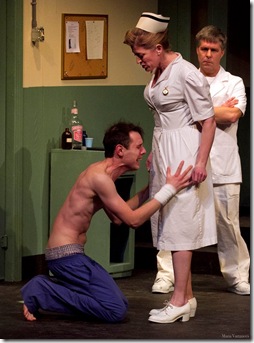One Flew Over the Cuckoo’s Nest: Performances capture the disturbing community of a psychiatric institution
Photo Maria Vartanova
The biggest mistake of Randle P. McMurphy’s life was not to break the law but to assume that serving his time in a mental institution would be easier than being sent to a work farm.
At first, he sees the “cuckoo’s nest” where he — the cuckoo — lands (modeled on the Oregon State Insane Asylum in the 1960s) as a breeze. He wins assorted bets with the other patients, brings a little sunshine into their lives, even persuades an apparently catatonic patient to talk and thinks he can win his battle with the sadistic head nurse.
But this is not a fight between equals. It is a power struggle between an administration that holds all the chips and a patient who has been committed and may not leave at will.
In some respects, One Flew Over the Cuckoo’s Nest, dramatized from Ken Kesey’s 1962 novel by Dale Wasserman, is dated. Electroshock treatments and lobotomies are no longer considered state-of-the-art treatments for mentally ill patients. Neither are the T-groups of the 1960s and 70s that ripped people apart emotionally (and did not always put them back together again) a regular part of therapy any longer.
What remains is the inequality and, for many patients, the fear of the outside world. Little wonder then that McMurphy, who thrived on worldly pleasures, should be a misfit among this group of misfits.
Yet, in bringing life to them, he makes them lively again and becomes an increasing threat to the controller.
All this is made clear in the Ottawa Little Theatre production of Cuckoo’s Nest, directed by Tom Taylor, as it was in the 1975 movie starring Jack Nicholson and Louise Fletcher.
As McMurphy, the disrupter, Jon Payne is appropriately strong, crude and blustering. His colourful personality dominates as the remaining patients first fade, then learn to shine a little through his encouragement.
Each of the group gives a portrait of a particular problem, well maintained throughout. As Billy Bibbit, the youngest patient torn up because he believes himself to be a bitter disappointment to his mother, J. Taylor Morris is particularly effective. Kenneth Forbes, in the key role of Chief Bromden, is a strong presence, although his recorded voice is frequently difficult to understand.
On the other end of the rope in the tug-of-war with McMurphy is Nurse Ratched, played coolly with a smile by Linda Webster. Although the style is intended as a contrast to Payne’s bluster, it sometimes masks her character’s sadism and determination to control patients and the rest of the staff a little too much to retain credibility.
However, in general, with solid technical backup from designers and crew, the ensemble in the OLT production of Cuckoo’s Nest create an unsettling picture of life in the disturbed ward of a mental hospital in the 1960s.
One Flew Over the Cuckoo’s Nest continues at the Ottawa Little Theatre to March 12.
By Dale Wasserman
Based on the novel by Ken Kesey
Ottawa Little Theatre
Director: Tom Taylor
Set: Robin Riddihough
Lighting: David Magladry
Sound: Andrew Hamlin
Costumes: Peggy Laverty
Cast:
Chief Bromden…………………………………………….Kenneth Forbes
Aide Warren……………………………………………….Doug Thicke
Aide Williams……………………………………………..Ryan Van Buskirk
Nurse Ratched……………………………………………..Linda Webster
Nurse Flinn………………………………………………..Marah Shields
Dale Harding………………………………………………Allan MacDonald
Billy Bibbit………………………………………………..J. Taylor Morris
Scanlon……………………………………………………Keith Bider
Cheswick………………………………………………….Geoffrey Wale
Martini……………………………………………………Christopher Torti
Ruckley……………………………………………………Eric Anderson
Randle P. McMurphy……………………………………..Jon Payne
Dr. Spivey…………………………………………………Ian Fraser
Aide Turkle………………………………………………..Howard Kaplan
Candy Starr………………………………………………..Sandy Wynne
Sandra……………………………………………………..Samantha Oxley
